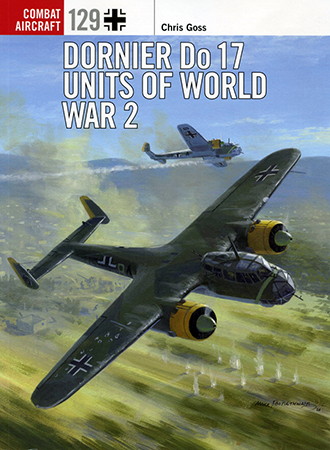
Dornier Do 17 Units of World War 2 Book Review
By David L. Veres
| Date of Review | August 2019 | Title | Dornier Do 17 Units of World War 2 |
|---|---|---|---|
| Author | Chris Goss | Publisher | Osprey Publishing |
| Published | 2019 | ISBN | 9781472829634 |
| Format | 96 pages, softbound | MSRP (USD) | $24.00 |
Review
Chris Goss charts the intriguing combat history of Nazi Germany’s “Flying Pencil” in Dornier Do 17 Units of World War 2 – 129th in Osprey’s “Combat Aircraft” range.
After an introductory chapter on the aircraft’s design, development, and initial deployments, coverage continues through five subsequent sections:
- Poland and Sitzkrieg
- Battle of France
- Battle of Britain
- Blitz
- New Horizons
Author Goss chronicles every Do 17 unit – personnel, operations, actions, duties, movements, losses, casualties.
During the Spanish Civil War, Legion Condor Do 17Es and Fs proved faster than Republican interceptors. But the Dorniers’ relatively scant bomb load consigned most to reconnaissance roles.
Blitzkrieg-era actions confirmed the growing obsolescence and vulnerability of all Do 17 subtypes. “[I]ntensity of [WWII] operations over both France and England during a seven-month period,” Goss notes, “saw the Dornier’s effectiveness as a frontline bomber steadily decline”.
As if to underscore the point, he adds that a Do 17P likely proved the Luftwaffe’s “first casualty of the Battle of Britain”.
With meager defensive armament, modest bomb load, limited range, and “alarming attrition” most Dorniers eventually switched to nocturnal and maritime missions. And by early 1941, Goss says, they were “rapidly becoming a rare sight in British skies”.
So it proved on all battlefronts. Replaced by more capable competitors, Dorniers disappeared from frontline Luftwaffe service. The Do 17Z-10 night fighter variant saw brief, lackluster use. And Do 17Z bombers fought in the Balkans and Barbarossa. But by late 1941, Luftwaffe examples went “almost extinct as … frontline combat aircraft”. One – the last of its kind – was salvaged from the sea off Kent in 2013. It remains under restoration.
Period photos and 30 color profiles illustrate the account. Extended captions, action accounts, and anecdotes further supplement the study. And appendices, color art commentary, and an index wrap things up.
But why no selected bibliography for further study? How about a glossary for neophytes to navigate Luftwaffe unit terminology and abbreviations? And why are Do 17 subtypes often unidentified in combat chronicles?
Finally, in describing the design’s earliest defensive armament, does Goss really mean “gondola”? And what does “with all bar KG 76 having Do 17s shot down” mean?
Still, Goss’ compact chronicle usefully recaps Do 17 battle service. Make it your introduction to this intriguing aircraft’s combat career.
Recommended!
My sincere thanks to Osprey Publishing for this review sample!







